
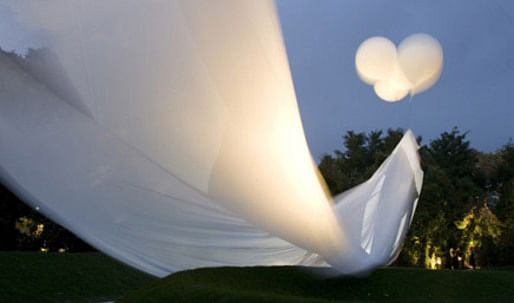
ShowCase is a series of features presenting exciting new work from designers representing all creative fields and all geographies.
We are accepting nominations for upcoming ShowCase features - if you would like to suggest a project, please send us a message.
Entitled Towards Paradise , the landscape installation is sited at the end of the Arsenale, within the overgrown grounds of the former Church of the Virgins, a Benedictine nunnery that was destroyed in the late 1800s. Gustafson Porter (London) and Gustafson Guthrie Nichol (Seattle) have been commissioned by Biennale Director Aaron Betsky to create this installation.
Towards Paradise is conceived as a contemporary allegory in the broadest sense. It takes the visitor on a journey through earthly dilemmas, evoking what has been lost and what can be gained. Telling a story of past, present and future, the garden is composed of three main spaces linked by pathways. In 'Remember', one is reminded of what has been lost. In 'Nourishment' one finds sustenance for body and soul. A clearing leads to 'Enlightenment' where a sculpted landform offers space for reflection, commemoration, conversation, contemplation and dreams of Paradise.
Towards Paradise responds to the challenge of how to cultivate one's garden, or how to tend to our affairs. In an idealistic world to have that capacity, one needs wisdom and a desire to search for wisdom. In French, ones 'Jardin Secret' is the private and protected part of one’s soul.
What are those needs that help us to cultivate our souls?
Towards Paradise seeks through allegory to tell a tale, a voyage of awareness and discovery. A voyage that seeks to question and provoke, in order that we may be able to tend to our affairs!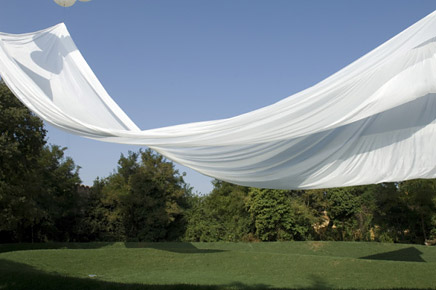
TOWARDS PARADISE
The allegory Towards Paradise follows a white gravel path of earthly dilemmas, passing from death to life and towards paradise. A past, present and future, the garden is composed of three main spaces carved into the existing bramble vegetation.
These are:
Remember – The Store Room
Nourish – Abundance
Enlighten – Contemplation
THE PRE EXISTING SITE
Positioned at the exit of the Arsenale, along the Porta Nova and the Rio delle Vergini, the site has been largely untouched for some time. The garden is located within the grounds of the Convento delle Vergini, Santa Maria in Gerusalemme, a Benedictine nunnery which was founded in 1239 and demolished in 1830. Historical maps reveal that formal gardens and vegetable allotments were once located within the grounds of the church.
A walk through the Corderia brings one to the Arsenale’s grand basin and a promenade of expectation that winds around its perimeter, below a covered dock and the final view towards a sentry tower guarding this vast historic arsenal from the lagoon beyond.
At the foot of the tower are small ruinous buildings, some with doors ajar, others barely visible below a growth of bramble and ivy, all set before the green backdrop of an ivy clad protective wall. Set before this architectural gathering, clothed in vegetation is the secret garden. A stand of wonderful Platinus hispanica (London Plane) trees loom over and protect its inner sanctum, all within is a tangle of plants and trees that struggle to keep their heads above a green tide.
REMEMBER STORE ROOM
From outside the visitor barely sees an opening through the thicket of ivy; however, the light gravel path leads the way into the ‘Store Room’. Inside the existing shelves are so large it is as if giants once used them. The wall at the back of the shelves is covered with the Latin names of extinct flora and fauna. A black light illuminates the white letters of the words, giving them a mysterious quality.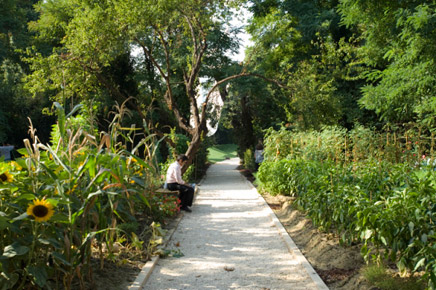
Upon leaving the Store Room the visitor is faced with two options: a tunnel straight ahead and a pathway following a brick wall to the left. Both paths are carved and threaded through the existing bramble. The tunnel is formed by an agricultural structure, protecting and guiding the garden’s visitors towards Nourishment. The pathway to the left follows a brick wall ensconced in ivy and leads visitors towards Enlightenment.
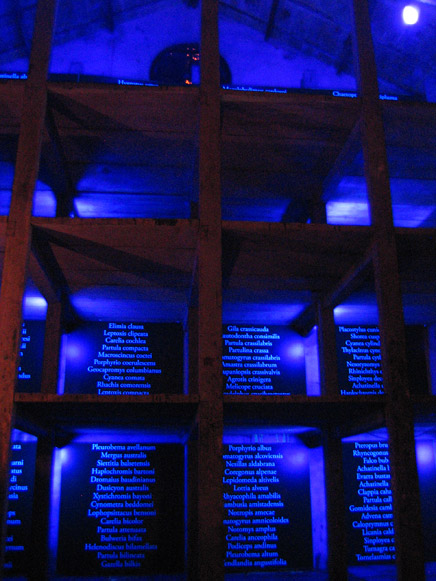
NOURISHMENT ABUNDANCE
Having passed through the tunnel one enters a large space; an illustration of the abundance of the plant world’s earthly and aesthetic delights. Rows of plants drooping with fresh fruits and vegetables invite the visitor to be aware of the abundance around them. Benches are placed throughout for people to sit, and absorb this sensory experience: smelling, seeing, and touching the lushness around them. The rectilinear layout is reminiscent of the vegetable and flower allotment gardens that once existed on this site.
The garden seeks to be a place for conversation, where one can tell or hear a story; a very colorful, dense, and richly textured space. This is a place of sustenance for the body and the soul, a place where each visitor is invited to reflect on the abundance in his or her own life.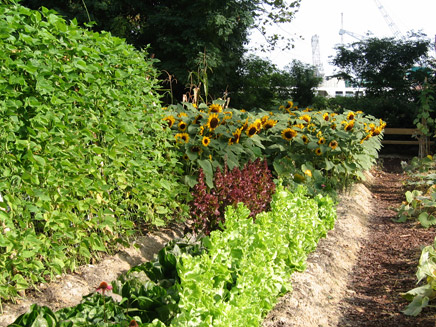

ENLIGHTMENT CONTEMPLATION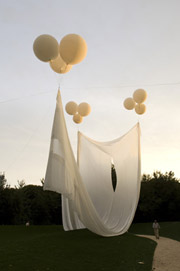
The visitor who leaves the Store Room and follows the pathway along the brick wall reaches a clearing in the overgrown garden, a secret place of enlightenment. This is a space of silence and simplicity, a place to reflect on all one has seen and experienced. A place to plot out how one is to cultivate one's own garden! The space is a long oval sculpted land movement covered in grass. White cushions are strewn throughout, providing informal seating. Amongst the tree canopies there are thin veils of white fabric. These ephemeral veils float high above the space, held in place with helium weather balloons. These cloud-like veils float high enough that they may be seen from the garden's entrance, creating intrigue and promise, thereby drawing people into the farthest part of the garden.
This quiet, contemplative, and magical space is designed to create a place of serenity where the visitor may sit and reflect; a place for them to take stock, nourish their soul, and hopefully find their own personal sense of enlightenment.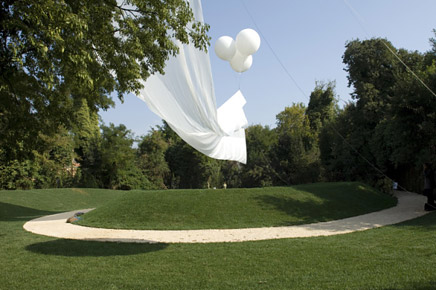
Gustafson Porter in London and Gustafson Guthrie Nichol in Seattle design innovative landscapes worldwide, operating across the diverse disciplines of landscape, architecture, engineering and design. Kathryn Gustafson established her landscape architecture practice in Paris in 1980 working as a sole practitioner and in collaboration with architects, artists and engineers. Her completed work in France encompasses a wide range of landscape projects from parks such as Fragments of Garden History (Les Jardins de l'Imaginaires) in Terrasson, landscapes associated with major buildings including the headquarters for Shell, Esso and L'Oréal near Paris and urban squares including The Square of Human Rights in Evry and Square Rachmaninov in Paris. Gustafson Porter Ltd was founded by Kathryn Gustafson and Neil Porter in 1997, with Mary Bowman joining the partnership in 2002. In 2000 Kathryn Gustafson, with partners Jennifer Guthrie, and Shannon Nichol, established the practice Gustafson Guthrie Nichol Ltd in Seattle. Together, the US and UK offices are engaged in projects across Europe, Asia, the Middle East and the United States, winning international acclaim for a growing portfolio of dynamic and exciting work.
No Comments
Block this user
Are you sure you want to block this user and hide all related comments throughout the site?
Archinect
This is your first comment on Archinect. Your comment will be visible once approved.